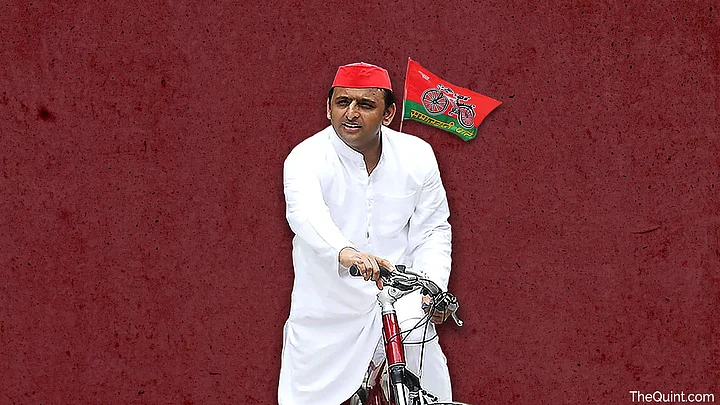Uttar Pradesh Chief Minister Akhilesh Yadav may have won the first battle against his father in the Election Commission of India by getting full control of the Samajwadi Party and its election symbol – the bicycle – but his real test for a bid to return to power starts now in the people's court.
Proceedings in the EC may have caused a delayed start to the Samajwadi Party's electoral preparations, but Akhilesh appears more than keen to make up for it by forging an umbrella alliance of major parties – the Congress and the Rashtriya Lok Dal (RLD).
Akhilesh is learnt to have done most of the homework about the possible alliances, which may be announced on Tuesday or at the most on Wednesday. Akhilesh’s wife, Dimple, had already met Priyanka Gandhi and sealed the deal.
Also Read: ‘Cycle Chalti Jayegi’, Akhilesh Tweets After Victory
Building a Non-BJP Alliance
The Samajwadi Party rode to power by winning 224 out of the total 403 Assembly seats in the 2012 polls by bagging 29.29 percent votes. The Congress, on the other hand, had secured 11.65 percent votes in an alliance with the RLD, which had mustered 2.33 percent votes.
But the emergence of the Modi phenomenon during the 2014 Lok Sabha polls saw the SP’s share dwindle to 22.35, while the Congress could manage just 7.53 percent and the RLD less than one percent. Together, the three parties hope to cross the threshold of 30 percent needed to form the government in UP.
The Congress is likely to contest about 90 seats, while the RLD will contest from 20 seats leaving 293 for the Samajwadi Party. Some regional players like – the Janata Dal (United), Trinamool Congress and Rashtriya Janata Dal (RJD), besides some minor parties like the Peace Party and Bharatiya Samaj Party – may also be drafted in within the the Samajwadi Party's quota later by giving a couple of seats to each one of them.
Akhilesh wants to project himself as a pro-development leader, who is being backed by most non-BJP leaders across the country. He has also acquired an image of being against the criminals. This is why his support base has extended beyond the usual Muslim-Yadav vote bank of the Samajwadi Party. He also enjoys a sizeable support among women.
Also Read: Akhilesh Wins SP’s ‘Cycle’ Symbol: Timeline of Events
UP’s Mahagathbandhan
Just imagine the reaction of the youth as Rahul Gandhi and Jayant Chaudhuri share the stage with Akhilesh Yadav. They have planned to address at least four rallies together. Similarly, Dimple and Priyanka will campaign together in a couple of constituencies.
Though the Congress could win only two Assembly seats out of 10 in Gandhis’ pocket borough – Amethi and Raebareli – during the 2012 election, the SP has agreed to let them contest all the ten seats this time.
Together, the Mahagathbadhan or the grand alliance hopes to emerge as the single largest group after the polls, keeping both the BJP and the BSP at bay.
Also Watch: Akhilesh Gets the SP ‘Cycle’; Supporters Express Joy
The EC Conundrum
The battle in the Election Commission was simple. Akhilesh had the numbers, but Mulayam was citing the party’s constitution. Akhilesh's case was presented by 5 advocates, while a battery of 11 lawyers put forth Mulayam’s arguments.
Akhilesh had presented supporting affidavits from 205 out of total 228 Samajwadi Party MLAs, 56 out of 68 MLCs, four out of five Lok Sabha MPs and 11 out of 19 Rajya Sabha MPs. If this was not enough, he also submitted supporting letters from 28 out of 46 National executive members and 5,242 delegates of the party.
Knowing that he did not have numbers on his side Mulayam Singh argued that there was no split in the party. In its 42-page order, the Election Commission maintained that the letters from Mulayam Singh and Amar Singh sent on 29 December, 30 December and 2 January had made it amply clear that the party had indeed split into two factions.
Also Watch: Akhilesh Wins the Dangal: A Timeline of How the Pari-War Unfolded
Now the challenge was to see which faction had the majority support in the party. Mulayam Singh's advocate Mohan Parasaran argued that the Akhilesh faction had flouted the party constitution by convening an unauthorised national convention. The election commission noted that a party can not stop functioning just because the party president does not convening a meeting. A meeting may be convened to elect a new leader, the EC said.
The Election Commission cited the number of precedents, including Sadiq Ali vs Election Commission of India and others, 1972. This is the most cited order applied by the commission in all disputes in recognised political parties with reference to Para 15 of the Symbols order.
(The writer is a Delhi-based senior journalist. He can be reached @sharadgupta1. The opinion expressed above is the author’s own. The Quint neither endorses nor is responsible for the same.)
